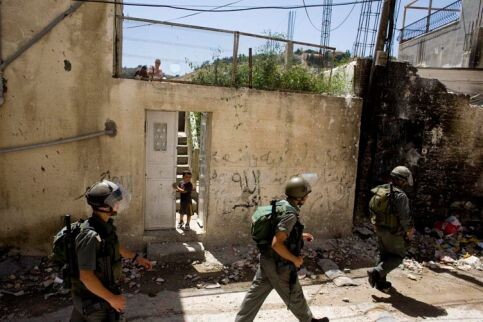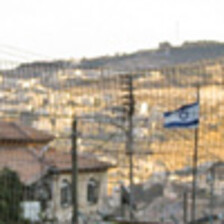The Electronic Intifada 2 July 2010

Israeli soldiers in Silwan, occupied East Jerusalem. (Meged Gozani/ActiveStills)
Israeli police detained residents of Silwan as bulldozers demolished a horse stable in the occupied East Jerusalem neighborhood on 29 June, while other construction vehicles razed a small warehouse to the ground in nearby Abu Tur. These demolitions came after Israeli courts decided that both of the buildings were built “illegally” and against “building codes.” In a statement from the court, Jerusalem mayor Nir Barakat said his office was upholding his position that “there is a right way and a wrong way, a right place and a wrong place to build in Jerusalem.”
Barkat’s “Master Plan” for the city includes accelerated Palestinian home demolitions, illustrated by his recently-announced plan to destroy 22 homes in Silwan, a neighborhood already ravaged by frequent house demolitions and takeovers of homes by armed Jewish settlers under protection from Israeli forces. “Earlier this week, after several years of controversy,” reported the Palestine Monitor on 26 June, “the city formally approved an incendiary plan to raze 22 homes in the al-Bustan block of Silwan to make way for tourist sites and urban development … Jewish development companies have wedged settlers into the Palestinian neighborhood and funded archaeological digging where Palestinian buildings once stood” (“Israelis, Internationals Take Action Against Silwan Demolitions”).
At least 500 demonstrators, including Palestinian, Israeli and international activists, took to the streets in Silwan on 25 June to protest the home demolition orders and the acceleration of Jewish settlement colony construction in the city. More than 50 individuals were wounded during fierce clashes as Israeli forces reportedly fired live ammunition, tear gas and percussion grenades at the crowds. One Palestinian man lost his eye when he was shot in the face with a percussion grenade and a Palestinian woman had a miscarriage after inhaling excessive amounts of tear gas, according to the Palestinian Maan news agency (“Five seized in Silwan, including 12-year-old child,” 29 June 2010). Maan also reported that a 19-year-old Palestinian woman, also pregnant, went into shock after Israeli forces attempted to invade her home; she was rushed to the Red Cross hospital and suffered a miscarriage.
Following the protests, Israeli forces abducted five Palestinians in Silwan during pre-dawn raids, including 12-year-old Baha al-Rajabi on 29 June, according Maan. Dozens of children in Silwan have been abducted, arrested and interrogated by Israeli police and border guards since the beginning of the year in what community leaders and parents categorize as deliberate attempts to terrify their most vulnerable population, thereby convincing families to abandon their neighborhood.
The Israeli human rights group B’Tselem points out that severe housing and building code restrictions and chronic, racially discriminatory refusals of building permits force Palestinian residents of Jerusalem to build without proper permits in areas such as Silwan, consequently making home demolition policies seem legitimate and a matter of simple bureaucracy: “The Jerusalem Municipality enforces the building laws on Palestinians much more stringently than on the Jewish population, even though the number of violations is much higher in the Jewish neighborhoods” (“Policy of discrimination in planning, building and land expropriation”).
In a statement distributed by Palestine Monitor, Dr. Mustafa Barghouti, Secretary General of al-Mubadara Palestinian National Initiative, said that the Silwan home demolition plan represents Israel’s efforts to judaize East Jerusalem using “insidious” bureaucratic measures. “Israel’s tools for negotiations with Palestinians are the bulldozers, the expansion of the settlement units, [and] changing the demographic composition of the city to favor the Jewish-Israeli population,” Bargrouti stated. “We are facing a systematic expulsion of Palestinians from Jerusalem which is against a future establishment of a fully sovereign Palestinian state” (“Barghouthi, Jerusalem Master Plan to Erase Palestinian Existence from the City,” 29 June 2010).
The European Union and the United Nations both condemned Israel’s plan, stating that it violates international law. EU foreign affairs chief Catherine Ashton also said on 30 June that the demolition of the 22 homes would be “an obstacle to peace.”
Zakariya Odeh, East Jerusalem resident, political activist and director of the Civic Coalition for Defending Palestinian Rights in Jerusalem, spoke to The Electronic Intifada (EI) following a sit-in protest at the offices of the International Committee of the Red Cross on Thursday, 1 July. Hundreds had gathered there to demonstrate against the Israeli government’s decision to expel four Palestinian politicians from occupied East Jerusalem this week after their residency rights were revoked last month.
Odeh told EI that Barkat’s “Master Plan” for Jerusalem is simply meant to push the city’s Palestinian population into narrower enclaves or force them to leave the country altogether. “The plan, the demolitions, the deportation issues — it is frustrating. As a human rights organization, we can’t do much other than advocacy and raising our voice against these injustices,” Odeh said. “People are fed up. You can see that Israel is not listening to any pressure by the international community; the government is just doing what it wants. They want to keep us a small minority in our own city. If this plan goes through, there is no future for Palestinians in Jerusalem.”
Elsewhere in occupied East Jerusalem, Maan reported on 28 June that Israeli construction vehicles and bulldozers broke ground for new Jewish-only settlement colony housing units near the illegal Pisgat Zeev settlement next to the Palestinian Shuafat refugee camp and the Beit Hanina neighborhood. The construction plan was originally announced in February 2010, and calls for 600 units to be built on primarily Palestinian-owned land.
Additionally, the Israeli regional planning committee announced that two hotels will be built on land belonging to Palestinians on the outskirts of the Jabal al-Mukkaber neighborhood. The Israeli Committee Against Home Demolitions (ICAHD) also reported on 29 June that Israeli forces demolished a stable, a fence, a road and several fruit trees in the Isawiya neighborhood, making it the sixth time demolitions have occurred in the last year as municipal policies actively restrict development in the area.
“The property belongs to a family who run a small farm on the site and who have the required permits to keep animals on the property,” ICAHD reported in a press release. “The legality of the demolitions, even under Israeli law, is unclear as court proceedings regarding the property were unresolved while the demolitions went ahead” (“Demolition in Isawiya Today,” 29 June 2010).
Meanwhile, many are connecting the crisis in occupied East Jerusalem to the broader situation for Palestinians under apartheid and military occupation across Palestine.
“The government led by Prime Minister Benjamin Netanyahu has set impossible conditions on all issues, including Jerusalem, borders, settlements, water and the Jordan Valley,” Dr. Barghouti remarked in his statement released by Palestine Monitor. “The answer to these policies lies in the expansion of the popular nonviolent resistance, the restoration of national unity and abandoning any illusion that the current negotiations will give positive results. We cannot wait for Israel to take serious and positive action, as it will never happen.”


